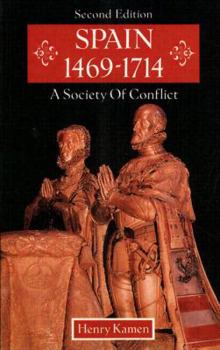Spain 1469-1714
Select Format
Select Condition 
Book Overview
For nearly two centuries Spain was the world's most influential nation, dominant in Europe and with authority over immense territories in America and the Pacific. Because none of this was achieved by... This description may be from another edition of this product.
Format:Paperback
Language:English
ISBN:0582067235
ISBN13:9780582067233
Release Date:January 1991
Publisher:Pearson
Length:328 Pages
Weight:0.85 lbs.
Dimensions:0.7" x 5.5" x 8.5"
Related Subjects
16th Century 17th Century Austria Europe History Modern (16th-21st Centuries) Portugal Spain WorldCustomer Reviews
1 rating
How conflicts shaped Spain
Published by Thriftbooks.com User , 23 years ago
Henry Kamen's Spain 1469-1714, a Society in Conflict is a political history spanning the growth and length of Spain's Imperialism and colonial empire. It is also a study of how religious conflict created among Catholics, Jews and Muslims shaped the political agenda of the crown. At the same time there were internal conflicts, Spain both as an alliance of Argon and Castile and later as a part of the Habsburg empire, then the Bourbons, was thrust into a global role in the new world, the Netherlands and Italy. It is a narrative/exposition approach that uses religious and economic strands as well as politics to explore the conflicts that shaped Spain as it passed from individual kingdoms into a modern state. Kamen provides an extensive bibliography including many Spanish sources, none of which appears to include original source material. Part one of the book focuses on the period from 1469 to 1516, which Kamen calls "The Catholic Kings." It is a time period that is often looked upon as Spain's golden age. The marriage of Ferdinand and Isabella united the kingdoms of Argon and Castile. Both kingdoms evolved in different ways which created potential sources of conflict. It was to Isabella and Ferdinand's credit that their major focus remained the pacification of Spain. Kamen investigates their pacification efforts through seven venues: hermandades, aristocracy, the municipalities, the Military Orders, the councils of state, justice and the Cortes. One of the contributing factors to conflict cited by Kamen throughout this period and all succeeding reigns was the crown's need to raise money. In spite of the wealth that came in from the America's, the Spanish treasury was always in need of money. Kamen, in effect, built as case for self-perpetuating conflict -conflict needs armies that needed money that created more conflict as the crown tried to raise it. The kings that followed Isabella/Ferdinand set different agendas. Charles V and his descendants committed themselves to Castile and their center of government. They financed their activities by tapping four major sources: Argon, Castile, the church and the Americas. However, the Americas never became the cash cow that the kings and councilors had hoped because the trade business was dominated by foreigners with Spain functioning only as a conduit. Consequently, the government periodically declared bankruptcy to cancel its debts. Religion was one of the other strands Kamen uses to develop his society in conflict themes. Phillip II, an extremely religious monarch, instituted the Inquisition. This required a nationalized church and its purpose was to reconvert the general population back to Catholicism. It coincided with the expelling of all the Moriscos which in itself created demographic problems and a lower tax base with its corresponding economic consequences. Kamen continues with the economic, religious and political conflict themes through the reig




